Picture this: you’ve bought yourself a beautiful old sports car and, like any good owner, have stored it out of the elements for the winter. You’ve also been careful to top-up all the fluids, remove the battery, and keep your vehicle in a moisture-free environment, so it’s in perfect condition for the spring.
When the first warm day of spring arrives, you couldn’t be more excited to take your pride and joy for a spin, so you spend the morning getting it all ready and attempt to fire up the engine.
But it won’t start.
You try again and again, but the car won’t turn over, and you’re left wondering what possibly could have gone wrong.
The answer is likely in the fuel.
Whenever your sports car, or any other vehicle, sits without running for more than a month, it’s essential to use a fuel stabilizer to prevent the gasoline from going bad and clogging the fuel system. In this guide, we’ll look at the top fuel stabilizers on the market.
- Factors to Consider When Buying Fuel Stabilizers
- Top 10 Best Fuel Stabilizers 2025
- 1. Best Overall Fuel Stabilizer: Star Tron Enzyme Fuel Treatment
- 2. Best Budget Fuel Stabilizer: STA-BIL Storage Fuel Stabilizer
- 3. Best Premium Fuel Stabilizer: Lucas Oil Fuel Stabilizer
- 4. Best Full Fuel System and Engine Protection: Sea Foam Motor Treatment
- 5. Best Multi-Purpose Fuel Stabilizer: Royal Purple Max-Clean Fuel System Cleaner and Stabilizer
- 6. Best Fuel Stabilizer For Diesel Engines: STA-BIL Diesel Fuel Stabilizer
- 7. Best Highly-Concentrated Fuel Stabilizer: PRI Fuel Stabilizer
- 8. Best Fuel Stabilizer For E10 Gasoline: Yamaha Fuel Stabilizer & Conditioner
- 9. Best Long-Term Fuel Stabilizer: B3C Fuel Solutions Ethanol Shield Stabilizer
- 10. Best Fuel Stabilizer With Octane Boost: K100 MG All-In-One Gasoline Fuel Treatment & Additive
- Guide to Buying the Best Fuel Stabilizers
- Wrapping Up
Factors to Consider When Buying Fuel Stabilizers
From the second you put fuel in your gas tank, it starts to degrade. Over a few months, the fuel can oxidize, forming gummy deposits that can clog up your fuel system and hinder your vehicle’s performance. It also makes the fuel less potent.
Additionally, most modern gas contains ethanol, a corrosive material that can damage fuel lines, gas tanks, and carburetors. Ethanol also attracts water, another corrosive substance, from the atmosphere, doing further damage to your fuel system.
Before looking at the best fuel stabilizers available today, you must know what to look for in a high-end product. After all, if the fuel stabilizer that you go with doesn’t last long enough or is too difficult to use, you won’t be happy with the result.
Longevity
Different fuel stabilizers last for different amounts of time, and the option you choose should generally depend on how long you wish to store your vehicle. As a rule, however, most reputable fuel stabilizers will keep your fuel in good shape for a year or two.
As a result, you can store your car or other motorized equipment for up to 24 months without worrying about the fuel oxidizing or any ethanol present damaging the fuel system.
Of course, you don’t necessarily need to choose an option that lasts for two years if you’re only storing your vehicle for a month or two at a time; the choice is up to you.
How Much To Use
The various fuel stabilizers on the market have different concentrations, affecting how much you’ll need to use in your car. The packaging instructions will let you know the approximate amount to allocate per gallon of fuel in your tank.
Some brands have a chart on the bottle’s side, so very little math is required, while others tell you to use the entire bottle. It’s OK to go over this approximate amount by a bit, but not putting enough fuel stabilizer into your tank could make it less effective.
Keep in mind that stabilizers with a lower concentration could end up costing you more, despite their lower sticker price, because you’ll have to put more in your tank than you would of a highly concentrated product.
Size
Hand in hand with the product’s concentration is the size of its bottle. Many top fuel stabilizers come in multiple sizes, allowing you to decide based on how much you need.
For example, if you’ll be storing multiple vehicles, or wish to use the product in your lawnmower, string trimmer, motorhome, and car, you’ll want a larger bottle. Likewise, if you’re only applying the stabilizer to your motorcycle, a smaller bottle will suffice.
Products with multiple size options make it easier to select a bottle that is right for you, especially since most fuel stabilizers have a shelf life of about two years after opening.
Ease of Use
If you’ve ever struggled to put oil in your car without spilling, you know how challenging it can be to pour things into your vehicle. The same can be said for fuel stabilizers, as you’ll have to get this liquid into your gas tank without making a huge mess.
Some products have spouts that you can insert into the tank, and even have a measuring mechanism built into the bottle. If you aren’t a mechanic, selecting an easy-to-use fuel stabilizer should be a priority because it lessens the potential problems you could encounter.
Other Considerations
Many well-known brands have fuel stabilizers on the market, and, despite some of these products also cleaning your fuel system and engine, the end goal is always the same: to prevent your gas from going bad and clogging your fuel system.
Generally, bad gas will prevent your engine from firing up, and in the worst-case scenario, could obstruct or damage your carburetor and fuel lines, forcing you to visit a mechanic. By putting a fuel stabilizer into your gas tank before storing your vehicle away, if even for a month, you can stop the gas from going bad.
Here’s a look at the top fuel stabilizers available in 2025.
| Product | Size of bottle | Easy to pour | Longevity | How much to use | Rating |
|---|---|---|---|---|---|
| Star Tron Enzyme Fuel Treatment | Eight ounces | Yes | Two years | One ounce per six gallons of gas | 5 |
| STA-BIL Storage Fuel Stabilizer | Multiple sizes between eight ounces and one gallon | Yes, except for the one-gallon jug | Two years | One ounce per 2.5 gallons of fuel | 5 |
| Lucas Oil Fuel Stabilizer | Multiple sizes between eight ounces and one quart | Yes | 12 months | One ounce per one gallon of gasoline | 4.5 |
| Sea Foam Motor Treatment | 16 to 20 ounces | No | Two years | One ounce per gallon of fuel | 4.5 |
| Royal Purple Max-Clean Fuel System Cleaner and Stabilizer | 20 ounces | No | Seasonal storage | One ounce per gallon of fuel | 4.5 |
| STA-BIL Diesel Fuel Stabilizer | 32 ounces or one gallon | Yes, in the 32-ounce option | One year | One ounce per five gallons when storing or ten gallons when operating the vehicle | 4.5 |
| PRI Fuel Stabilizer | 16 ounces | Yes | One year | One ounce per 16 gallons | 4 |
| Yamaha Fuel Stabilizer & Conditioner | 32 ounces | Yes | One year | One ounce per one gallon when storing; one ounce per three gallons when occasionally running | 4 |
| B3C Fuel Solutions Ethanol Shield Stabilizer | 24 ounces | Yes | Three years | One ounce per ten gallons of fuel | 4 |
| K100 MG All-In-One Gasoline Fuel Treatment & Additive | 32 ounces | Yes | Two years | One ounce per gallon | 3.5 |
Top 10 Best Fuel Stabilizers 2025
1. Best Overall Fuel Stabilizer: Star Tron Enzyme Fuel Treatment

Editor’s Rating:
Quick Facts:
- Size of bottle: Eight ounces
- Easy to pour: Yes
- Longevity: Two years
- How much to use: One ounce per six gallons of gas
Star Tron Enzyme Fuel Treatment is a top fuel stabilizer option because not only does it keep the gas in your tank fresh, but it can make old gas usable again. Yes, if you have old gas in a fuel tank or gas can, this treatment can bring it back.
This product ensures that your vehicle will start up and run smoothly after lengthy storage and eliminates the need to drain your tank before storing your car for the season. The product is expensive when used as a fuel treatment because you’ll have to put some in every time you fill up, but an excellent option as a fuel stabilizer for the occasional user.
Using the Product
Star Tron Enzyme Fuel Treatment has a long spout, making it easy to pour into the gas tank without spilling. You’ll want to use one ounce of stabilizer for every six gallons of gasoline, and there’s a measurement guide on the side of the bottle showing you how much you’re putting into the tank.
Remember, the frequency with which you use the product depends on your preferences. If you’re only using it for storage, you’ll measure the necessary amount and put it in your tank before storing the vehicle. Since the product also acts as a fuel treatment, you might re-administer it every time you fill your tank, as well.
Verdict
Overall, Star Tron Enzyme Fuel Treatment does an outstanding job of not only keeping fuel fresh but protecting the entire fuel system from damage. The main drawback is its price, as having to administer one ounce for every six gallons of gas adds up if you’re using it to treat your car after every fill. At the same time, its eight-ounce bottle is under $10 and can treat 48 gallons of fuel, making it a solid option for the annual user.
Pros
- Keeps gas fresh
- Easy to pour
- Good for long-term storage
- Prevents fuel system problems
Cons
- Small bottles
- Can get expensive
2. Best Budget Fuel Stabilizer: STA-BIL Storage Fuel Stabilizer
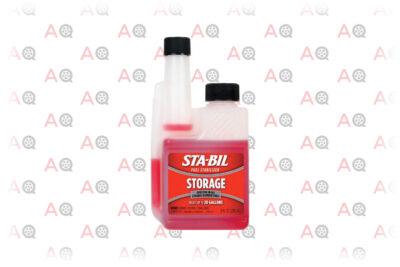
Editor’s Rating:
Quick Facts:
- Size of bottle: Multiple sizes between eight ounces and one gallon
- Easy to pour: Yes, except for the one-gallon jug
- Longevity: Two years
- How much to use: One ounce per 2.5 gallons of fuel
Unlike other fuel stabilizers that also clean the fuel system, freshen up old gas, and improve your gas mileage, STA-BIL Storage Fuel Stabilizer has one job: to keep your gasoline stable. The good news is that this product is excellent at preventing your fuel from oxidizing and damaging your fuel system because it does this one job extraordinarily well.
If you’ll be removing your car from storage to occasionally drive it or want something that’ll clean your fuel system while you go, you might look to another product like Royal Purple Max-Clean Fuel System Cleaner and Stabilizer. If you’ll be storing your vehicle for months at a time, or even up to two years, however, STA-BIL Storage Fuel Stabilizer is a great product.
Using the Product
STA-BIL Storage Fuel Stabilizer is incredibly easy to use because of its long spout. Keep in mind that the one-gallon jug doesn’t have this spout, making it more challenging to pour into your gas tank. The product also has measurement units built onto the side of the bottle, giving you a rough idea of how much you’re putting into the tank. To use the product, you’ll want to fill your tank at least 95% full before topping it up with fuel stabilizer and letting the engine run for five minutes.
Verdict
If you plan to let your vehicle sit for more than 30 days, STA-BIL Storage Fuel Stabilizer will ensure that your fuel stays fresh and doesn’t rust your carburetor. It’ll also protect your engine from gumming up and remove moisture from your gasoline, preventing corrosion. The main problem is that it takes one ounce of product to treat 2.5 gallons of fuel, so you’ll need a lot of it to protect an entire tank of gas.
Pros
- Multiple sizes
- Excellent fuel system protection
- Keeps gas fresh for two years
- Easy to use
Cons
- Need a lot of it
- Doesn't clean the fuel system
- Only for fresh gas
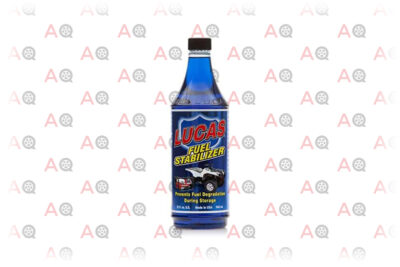
Editor’s Rating:
Quick Facts:
- Size of bottle: Multiple sizes between eight ounces and one quart
- Easy to pour: Yes
- Longevity: 12 months
- How much to use: One ounce per one gallon of gasoline
Lucas Oil is a big name in the car care industry, so it should come as no surprise that their fuel stabilizer is one of the best options on the market. This product does an outstanding job of preventing fuel from breaking down during storage and also cleans your fuel pump, compression rings, carburetor, and fuel injectors.
Lucas Oil Fuel Stabilizer is a top product in this industry, with the one issue being the cost because, unlike long-term brands like B3C Fuel Solutions Ethanol Shield Stabilizer, it only lasts for 12 months, and you’ll have to use one ounce per every gallon of fuel.
Using the Product
One of the best aspects of Lucas Oil Fuel Stabilizer is its ease of use, as all bottles, even the one quart, come with an easy-pour spout. All you’ll do to use this product is pour it into a gas tank full of fuel and let the engine run for a few minutes before storing your car for the winter. You’ll likely need close to a full quart of stabilizer to treat a tank of gas, which might exclude you from using Lucas Oil Fuel Stabilizer on a large scale.
Verdict
Overall, Lucas Oil Fuel Stabilizer does its job exceptionally well and provides maximum protection for your engine and fuel system for about 12 months. While a year seems like a long time, this product doesn’t come close to the two-year or three-year storage capabilities of other brands. However, for short-term storage of a single vehicle, Lucas Oil Fuel Stabilizer is a premium option that’s worth considering.
Pros
- Top-quality brand
- Makes old gas usable
- Cleans your fuel system
Cons
- Only keep fuel stable for one year
- Uses one ounce per gallon
4. Best Full Fuel System and Engine Protection: Sea Foam Motor Treatment
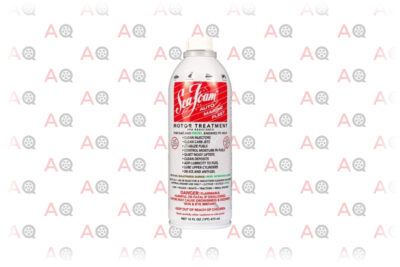
Editor’s Rating:
Quick Facts:
- Size of bottle: 16 to 20 ounces
- Easy to pour: No
- Longevity: Two years
- How much to use: One ounce per gallon of fuel
First and foremost, Sea Foam Motor Treatment is a product that cleans and lubricates various engine components like your injectors, carburetor, intake valves, and pistons. At the same time, you can use the product as a fuel stabilizer, as it prevents both gasoline and diesel from oxidizing and forming gummy deposits for up to two years.
Keep in mind that when using this product as a stabilizer, its one ounce per one gallon of fuel ratio means you’ll need roughly two full bottles per tank of gas.
Using the Product
Unlike products with a long spout, Sea Foam Motor Treatment is a little more difficult to use because of its short neck. It comes in a shorter bottle because you’ll often use the product as an engine treatment and pour it directly into the crankcase. As a result, you’ll have to be careful when emptying it into your gas tank.
You should also know that Sea Foam Motor Treatment is a liquid, despite its name, and will spill if you don’t take the proper care.
Verdict
Sea Foam Motor Treatment is an excellent choice for treating your entire fuel system as you drive or when seeking a product to use in both diesel and gasoline engines. The product works well as a fuel stabilizer, although it doesn’t live up to its full potential when you have the car in storage. To get the most of Sea Foam Motor Treatment, you’ll want to run your vehicle occasionally to let it do its thing. If your car will be sitting for weeks at a time between use, Sea Foam is worth picking up. If it spends months in storage, you might want to keep looking.
Pros
- Cleans your engine
- Works in gasoline and diesel engines
- Has multiple formulations
Cons
- Difficult to pour
- Not for car storage
5. Best Multi-Purpose Fuel Stabilizer: Royal Purple Max-Clean Fuel System Cleaner and Stabilizer
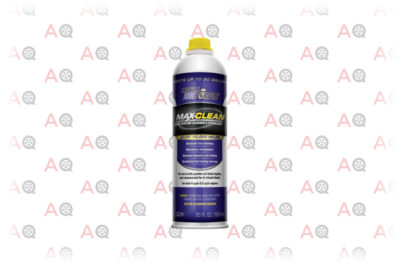
Editor’s Rating:
Quick Facts:
- Size of bottle: 20 ounces
- Easy to pour: No
- Longevity: Seasonal storage
- How much to use: One ounce per gallon of fuel
Much like Sea Foam Motor Treatment, Royal Purple Max-Clean Fuel System Cleaner and Stabilizer is a product that does some good for the entire fuel system. Royal Purple works on both diesel and gasoline engines and can improve your fuel economy, reduce your emissions, and restore your vehicle’s horsepower.
As a fuel stabilizer, Royal Purple Max-Clean Fuel System Cleaner and Stabilizer can prevent the gas in your tank from going bad over the winter, so you won’t have to drain your tank before storing your vehicle. The issue with this product is that it’s best used as a fuel system cleaner, so you probably aren’t getting the most from it when using it as a stabilizer.
Using the Product
Royal Purple Max-Clean Fuel System Cleaner and Stabilizer comes in a 20-ounce bottle that doesn’t have an easy-to-pour spout. As a result, you’ll have to take some care to avoid spilling. The fact that the product only comes in a single size capable of treating 20 gallons of fuel means you might need multiple bottles if you wish to stabilize a full tank of gas.
Verdict
Royal Purple Max-Clean Fuel System Cleaner and Stabilizer is a great product that does everything that it’s supposed to do. If you’re just looking for a fuel stabilizer as someone who occasionally uses their car, this is one of the best options on the market. If your car goes into storage for months at a time without being used, a more specialized product like PRI Fuel Stabilizer might be your best bet.
Pros
- Cleans your fuel system
- Great for occasionally-used vehicles
- Reduces emissions
Cons
- Requires one ounce per gallon
- No easy-pour system
- Not for long-term storage
6. Best Fuel Stabilizer For Diesel Engines: STA-BIL Diesel Fuel Stabilizer
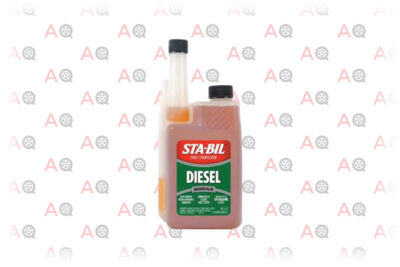
Editor’s Rating:
Quick Facts:
- Size of bottle: 32 ounces or one gallon
- Easy to pour: Yes, in the 32-ounce option
- Longevity: One year
- How much to use: One ounce per five gallons when storing or ten gallons when operating the vehicle
Although other products like Royal Purple Max-Clean work on diesel engines, STA-BIL Diesel Fuel Stabilizer is formulated for vehicles that run on diesel and one of the best in that role. This product prevents sediment and sludge from forming inside your engine, and also reduces oxidation and removes water from your diesel fuel.
The key is that this product addresses problems related to ultra-low-sulfur diesel fuel (ULSD), the standard in North America, which can promote thermal fuel oxidation, corrosion, sediment formation, and lubrication issues.
The drawbacks are that the product only protects the fuel for about 12 months, and you’ll have to reapply it every time you fill the tank when not using it for storage purposes.
Using the Product
The 32-ounce bottle of STA-BIL Diesel Fuel Stabilizer comes with an easy-pour spout that includes a measurement guide to ensure you’re using the right amount. This stabilizer size will treat 320 gallons of fuel when you’re occasionally running the vehicle or 160 gallons for storage. This 32-ounce bottle will cost you over $20, but it’s highly-concentrated, so you’ll get good bang for your buck.
The one-gallon jug of STA-BIL Diesel Fuel Stabilizer isn’t as easy to pour into your tank because it doesn’t have the spout. The larger bottle also lacks the measurement units on the jug’s side, so you’ll have to ballpark or measure it when adding the product to your fuel tank.
Verdict
If you have a vehicle with a diesel engine, STA-BIL Diesel Fuel Stabilizer is a top choice because it is specially formulated to reduce the problems associated with ultra-low-sulfur diesel fuel. You don’t want to leave this fuel in your tank for months at a time without a fuel stabilizer that prevents it from taking on moisture, and this product is one of the best at this job. One bottle also treats a ton of fuel, but be aware that it only keeps diesel fresh for 12 months.
Pros
- Reduces ULSD problems
- Treats a lot of fuel
- Simple to use
- Formulated for diesel
Cons
- Only lasts for 12 months
- Have to use more of it when storing the vehicle
7. Best Highly-Concentrated Fuel Stabilizer: PRI Fuel Stabilizer
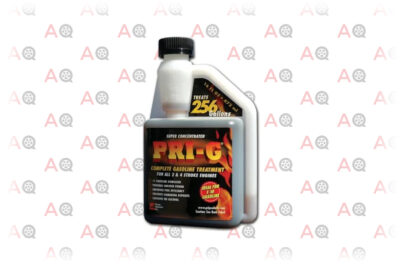
Editor’s Rating:
Quick Facts:
- Size of bottle: 16 ounces
- Easy to pour: Yes
- Longevity: One year
- How much to use: One ounce per 16 gallons
There’s a lot to like about PRI Fuel Stabilizer, as this product is industrial-grade, and you’ll only need to use one ounce of it for every 16 gallons of fuel, compared to one ounce per 2.5 gallons of fuel when using STA-BIL Storage Fuel Stabilizer. The result is that a 16-ounce bottle will last for years, although you should be aware that its shelf life is only three years from the time of opening and a bottle of it will run you somewhere in the $30 range.
As far a performance goes, PRI Fuel Stabilizer is one of the best at restoring old fuel to usable condition, which could save you from having to empty a tank containing stale gas. You’ll also notice that this product prevents deposits from forming in your fuel system and can improve your fuel economy.
Unfortunately, each treatment of the fuel only lasts for about a year. However, you can add another ounce or so of PRI Fuel Stabilizer to your gas tank annually to keep its contents fresh and prevent oxidation.
Using the Product
You shouldn’t have any trouble using PRI Fuel Stabilizer because its bottle comes with an easy-to-use spout that will measure the right amount for you. This spout works in half-ounce and one-ounce increments, allowing you to get as close as possible to the ideal amount of fuel stabilizer. It doesn’t take much to stabilize an entire tank of fuel, making this an excellent option for fleet owners or those with multiple vehicles they’ll be storing for the winter.
Verdict
As far as quality and ease of use go, PRI Fuel Stabilizer is a great option. Once you buy a bottle of this product, you won’t have to worry about re-purchasing for at least a few years, which should help you come to terms with the high upfront cost. You’ll also have to remember to add more stabilizer every year if you plan to store your car for a long time, but that’s a relatively rare issue.
Pros
- Highly-concentrated
- Restores old fuel
- Protects your fuel system
Cons
- Only lasts one year
- High cost
8. Best Fuel Stabilizer For E10 Gasoline: Yamaha Fuel Stabilizer & Conditioner
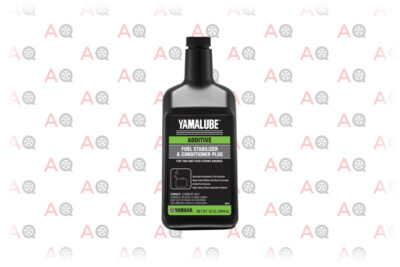
Editor’s Rating:
Quick Facts:
- Size of bottle: 32 ounces
- Easy to pour: Yes
- Longevity: One year
How much to use: One ounce per one gallon when storing; one ounce per three gallons when occasionally running
Yamaha Fuel Stabilizer & Conditioner is formulated for E10 gasoline. What’s E10 gasoline, you ask? Well, it’s the type of gas you’ll find at most pumps in the United States and contains up to 10% ethanol. This information is vital because ethanol retains water, which can corrode elements in your fuel system.
All of this is a fancy way of saying that this product will prevent ethanol-related problems when leaving gas in your tank, but it’s nice to know that it’s formulated for the exact gasoline that you’re probably putting in your car. You’ll likely have to use an entire bottle of this product to store a vehicle, making it an expensive choice.
Using the Product
A bottle of Yamaha Fuel Stabilizer & Conditioner comes with a long spout, making it an easy product to get into your gas tank. From there, it’ll keep your fuel stable for about a year, so your engine should start right up after being in storage for a season or two.
Verdict
You could say that there isn’t anything special about Yamaha Fuel Stabilizer & Conditioner, as it does the bare minimum that you’d expect from a fuel stabilizer. At the same time, it does this job relatively well, albeit at an inflated price compared to other options on the market.
Pros
- Formulated for E10 gasoline
- Comes in a large bottle
- Reduces moisture-related problems
Cons
- Lots needed for storage
- Only protects for one year
9. Best Long-Term Fuel Stabilizer: B3C Fuel Solutions Ethanol Shield Stabilizer

Editor’s Rating:
Quick Facts:
- Size of bottle: 24 ounces
- Easy to pour: Yes
- Longevity: Three years
- How much to use: One ounce per ten gallons of fuel
B3C Fuel Solutions Ethanol Shield Stabilizer works by eliminating problems associated with ethanol fuels, such as moisture getting into the fuel system and causing corrosion. The product also lubricates and protects the top end of the engine and keeps gas usable for up to three years.
You’ll be happy to learn that Ethanol Shield Stabilizer is highly-concentrated. Although it’s not concentrated to the level of PRI Fuel Stabilizer, you’ll only have to use one ounce for every ten gallons of fuel. Your 24-ounce bottle will last for years, making this a rare purchase for your household. There aren’t any extra here, as the product doesn’t clean your engine, and it’s pricier than other options, like STA-BIL Storage Fuel Stabilizer, but it’ll keep your fuel stable long-term.
Using the Product
The long neck on the bottle of B3C Fuel Solutions Ethanol Shield Stabilizer makes it simple to get into your tank without spilling. From there, you’ll want to run your engine for a short time to ensure that the product reaches all parts of your fuel system, especially your carburetor. Ethanol can attract water and clog up your fuel system, but this product prevents gummy fuel from becoming an issue by stopping the gas in your tank from breaking down.
Verdict
B3C Fuel Solutions Ethanol Shield Stabilizer is a product that has one job and does it well. If you’ll be storing your vehicle for more than a few weeks, and up to three years, this stabilizer will do what it’s supposed to without worry.
You’ll want to look elsewhere if your fuel system is overdue for a cleaning, and you want an easy solution. However, if your fuel system is in good shape and you want to keep it that way without emptying your tank, Ethanol Shield Stabilizer can work for you.
Pros
- Removes moisture from ethanol fuels
- Highly-concentrated
- Lasts for three years
Cons
- Doesn't clean the fuel system
- High upfront cost
10. Best Fuel Stabilizer With Octane Boost: K100 MG All-In-One Gasoline Fuel Treatment & Additive

Editor’s Rating:
Quick Facts:
- Size of bottle: 32 ounces
- Easy to pour: Yes
- Longevity: Two years
- How much to use: One ounce per gallon
K100 MG All-In-One Gasoline Fuel Treatment & Additive treats the entire fuel system, preventing phase separation and improving fuel performance. The end result is a better performing car with reduced emissions and a cleaner-running fuel system.
There’s also the product’s octane boost capability, which can increase a fuel’s octane rating by as much as two points. While this doesn’t impact performance, it can prevent engine knocks caused by premature ignition in your car’s cylinders.
As a fuel stabilizer, K100 MG All-In-One Gasoline Fuel Treatment & Additive can stop fuel from going bad for up to two years and bring back old gas to a usable state. You’ll have to use the entire bottle on a full tank of gas, making this an expensive option.
Also, the product isn’t specialized for fuel stabilization, so it could be harder to get your engine started after lengthy storage than with a premium fuel stabilizer.
Using the Product
Like a lot of other products on this list, K100 MG All-In-One has a long neck that makes it easy to get into your gas tank. You’ll want to add it to your tank either before or after filling it with fuel. From there, the product’s composition allows it to easily mix with the fuel, moving it throughout the fuel system as the engine runs.
An entire bottle is often required to treat a tank of gas. If you’re stabilizing a smaller amount of fuel, you can use its cap to measure, with eight caps equaling one ounce of fuel stabilizer.
Verdict
K100 MG All-In-One Gasoline Fuel Treatment & Additive is an excellent product that can do a lot of good for your vehicle’s fuel system. It can also stabilize stored fuel for up to two years, but other products on the market are more effective and economical when used solely as a fuel stabilizer.
Pros
- Provides an octane boost
- Cleans your fuel system
- Brings back old fuel
Cons
- Need to use lots of it
- Better as a fuel system treatment than a stabilizer
Guide to Buying the Best Fuel Stabilizers
With so many fuel stabilizers on the market, selecting the best one to meet your needs is a challenge. Here’s some additional information to help you make your decision.
How Fuel Stabilizer Works
A fuel stabilizer is a protective, petroleum-based substance that bonds to gasoline or diesel, preventing evaporation, oxidation, and chemical breakdown from occurring. The product also repels moisture that ethanol-based fuels can often absorb.
Fuels with ethanol are widespread today and bond efficiently to water. As this reaction occurs, the gasoline turns into a gummy blob that sits on the floor of your fuel tank or, worse, moves throughout your fuel system, clogging its components. This process is called phase separation, and it ruins your gas, reduces its octane levels, and damages your engine.
The chemicals in your fuel stabilizer work to prevent all of the negative aspects of fuel oxidation and water absorption, keeping your gas fresh and your engine free from the gummy deposits that this reaction creates.
Why You Need a Fuel Stabilizer
We know that, on the surface, you need a fuel stabilizer to protect your car’s fuel system, but why does the very thing your vehicle needs to operate damage its internal components?
The answer is in the type of fuel we use today.
About 98% of fuel sold in the United States contains ethanol, a renewable source that comes from plant-based materials called biomass. The vast majority of this fuel is called E10, which contains 90% gasoline and 10% ethanol. The idea is that ethanol causes less air pollution when burned. It also has a positive energy balance because its energy output is greater than the amount of energy it takes to create.
Laws, including the 1990 Clean Air Act and the Energy Independence and Security Act of 2007, have provisions outlining and governing ethanol’s use in today’s gasoline.
The problem is that cars aren’t designed to burn ethanol, and, as we’ve mentioned, this fuel causes all kinds of problems for engines and fuel systems. It also causes gasoline to break down faster, leading to the need for fuel stabilizers.
Fuel Stabilizers in Diesel Engines
For diesel engines, the need for a fuel stabilizer comes from the mandate for drivers to use ultra-low-sulfur diesel in their vehicles. The gist is the EPA has numerous laws in place that limit the amount of sulfur in the fuel you can buy.
These laws have done an excellent job of reducing emissions, which is good because sulfur oxides are dangerous to the environment and a human health concern, but they’ve also changed the chemistry of diesel fuel.
Hydrotreating, the process that removes sulfur from diesel, also eliminates the fuel’s natural lubricity compounds and makes it easier for it to absorb water. We’ve learned how dangerous water can be to fuel systems and engines, so using a stabilizer to bond to and remove this moisture is a good idea.
Types of Fuel Stabilizers
As you might have noticed, some products on this list will only stabilize your fuel and little else, while others will clean your fuel system or treat your engine, as well.
So, which one is best for you?
It all comes down to your reason for purchasing the product.
Generally, standalone fuel stabilizers are the best for long-term storage because you won’t be driving the vehicle to capitalize on the benefits of the fuel system treatment. Since the products that include engine treatment are often more expensive, it makes sense to stick with the economical option that performs the exact job you’re seeking.
At the same time, if you’ll continue to drive your car after using the fuel stabilizer, you might choose one that has these additional features because they’ll do your car’s engine components some good.
The Lifespan of Gasoline and Diesel
If you still aren’t sure if you need a fuel stabilizer for your vehicle, you should know how quickly gasoline breaks down. While there isn’t a definite amount of time that this process takes, gasoline containing ethanol can start to degrade within 30 days. After you’ve had gasoline sitting in your tank for over 30 days, the ethanol can start damaging your fuel system.
Ethanol also loses its combustibility in less than three months, making it far more challenging to get your engine started. If you’re refilling your car less than once a month, a good fuel stabilizer is a necessity to prevent fuel system damage.
Diesel, even today’s low-sulfur product, lasts a bit longer than gasoline, as you can keep it in your tank for about six months before it goes bad. At the same time, diesel can begin gumming up your fuel system in as little as 30 days, making a diesel fuel stabilizer a good idea.
What Happens When Gas Loses Potency
One of the symptoms of old gas is that it doesn’t burn as effectively, causing problems when trying to start your engine.
Gas is a volatile product that goes through a refining process to give it the exact chemical composition it requires to work in your vehicle. The gas vaporizes in your fuel system, so your internal combustion engine can use it to power the car.
The most volatile components in the gasoline, or the attributes that allow it to create the energy your vehicle needs, tend to evaporate over time. As these components evaporate, the gas burns less efficiently, making it difficult to start your engine.
Fuel stabilizers can slow down this evaporation, so your gas doesn’t lose its potency as rapidly.
Using Fuel Stabilizers on 2-Stroke Engines
We’ve spent a lot of time going over how to use fuel stabilizers in your car, but what about other engines? Well, all of these products, except for STA-BIL Diesel Fuel Stabilizer, work in all two-stroke and four-stroke gasoline engines.
As a result, you can use a fuel stabilizer in your lawnmower, string trimmer, motorcycle, dirtbike, or any other machinery that will have gasoline sitting in its fuel tank for more than a few weeks.
STA-BIL Diesel Fuel Stabilizer is also for use in diesel generators if you have one that you occasionally use and are worried about the fuel quality.
Can You Use Too Much Fuel Stabilizer?
Since you’ll have to measure how much fuel stabilizer you’re putting into your tank, you might be worried about putting too much in and damaging your car.
Using too much of these products isn’t usually a concern, however, as it’s close to impossible to “overdose” on fuel stabilizer, at least within reason. In fact, if you’re unsure about your measurements, you’re better off putting too much product into your gas tank than too little.
Basically, too little fuel stabilizer could cause the product to fail, while too much won’t affect it whatsoever. You don’t want to fill your entire tank with the stuff, but it’s no big deal if you’re a little over the prescribed amount.
Fuel Stabilizers in Stored Gas
Much of this topic has focused on fuel left in your gas tank, and that’s because this fuel can actively damage your car. Fuel stabilizers are also useful if you’re storing some emergency fuel in a gas can or keeping some gas around to refuel your lawnmower in the summer.
In this case, you’ll likely want a storage fuel stabilizer with the most extended shelf life because there’s no telling when you’ll actually use the gas. Of course, if you’ve bought a fuel stabilizer with fuel treatment capabilities for your car and have some leftover, it won’t hurt anything to use it in your stored gas can.
Wrapping Up
Your vehicles and other gas-powered equipment are valuable, and you want to do everything in your power to protect them from damage. Putting a little bit of fuel stabilizer into your tanks when your cars or tools will sit without being used can save you all kinds of hassle and repair costs, making it well worth the effort. For the best results, find the product that provides the coverage that meets your needs and keeps your engines and fuel systems in working order.


